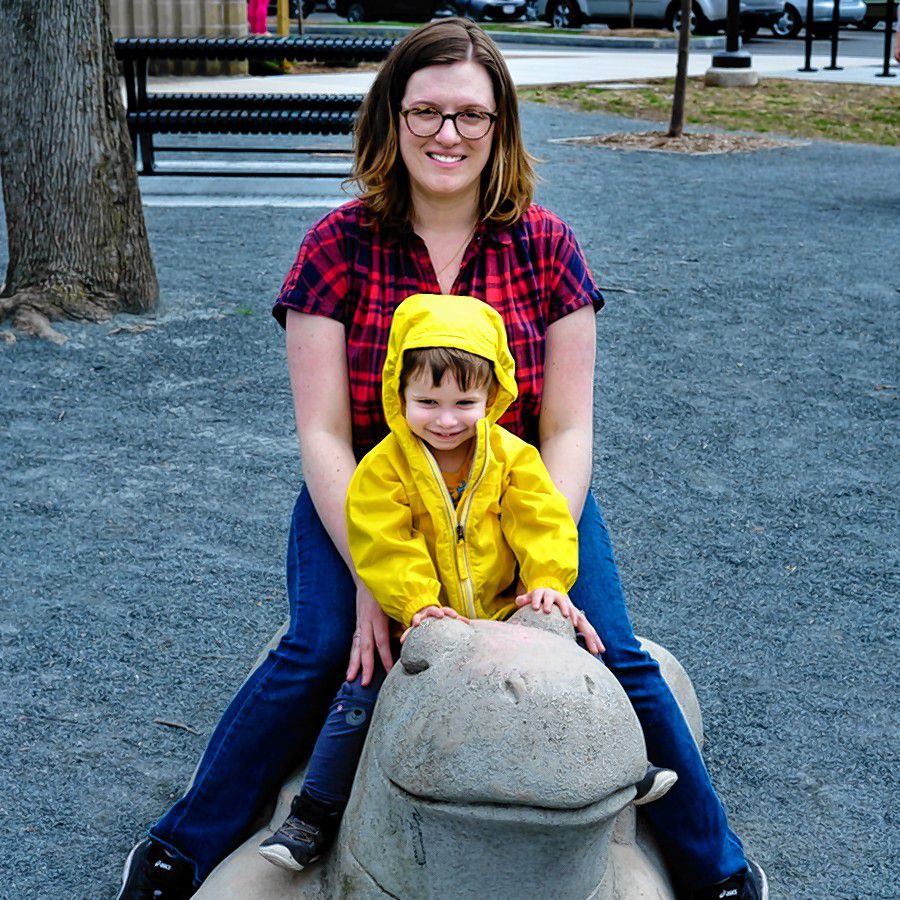After his evening bath, my 2-year-old son entered the living room with a delighted smile on his face. My husband trailed cheerfully behind him, having successfully accessed our son’s figurative reset button. A bath is one of the few things that can put our child in an instant good mood, and when you’re the parent of a temperamental toddler, you milk this kind of cure-all for all it is worth.
Suddenly, our son tore across the living room screaming, “No! No! Not your hair!” He collapsed dramatically into my lap, weeping, “Your hair… your hair….” I released my hair from its ponytail, and rolled my eyes at my husband to convey exasperation. When Mama’s hair is up, our kid recently decided, all is not right in the world. Taking my hair down was enough to halt a complete meltdown, and if I have learned anything over the last five months, that’s a small price to pay for a calm evening.
 I’ve been a stay-at-home parent since my son was born. This experience has been wonderful. To witness him grow and learn so much over the last 27 months is something I feel so honored to have done. He is the product of my hard work and patience. He is smart and funny, gives the best hugs, and is possibly the world’s youngest breakfast cereal connoisseur.
I’ve been a stay-at-home parent since my son was born. This experience has been wonderful. To witness him grow and learn so much over the last 27 months is something I feel so honored to have done. He is the product of my hard work and patience. He is smart and funny, gives the best hugs, and is possibly the world’s youngest breakfast cereal connoisseur.
For a long time, I thought we made an indivisible team, but right before his second birthday he started to assert his autonomy. Then my confidence as a parent was shaken by his shocking endurance to tantrum for eons at a time. I knew that the “terrible twos” would arrive, but as it turned out, actually experiencing toddlerhood threw me off course. How could I be a “good” parent when I was totally unable to make my kid feel better?
The first tantrum lasted a full 60 minutes. He lay thrashing and crying on the living room floor while I, the ineffectual parent, attempted to give hugs and speak gentle reassurances. Everything I did just made the situation worse, so I texted my mother who just so happens to be an authority on early childhood education.
She advised that I give him space to cry, but to remain within his sight. As a parent who has never seen her child have such big feelings, this was hard advice to follow. I’m supposed to ignore the instinct to comfort my child? Doesn’t he need me to help him get to the bottom of his distress? Eventually he stopped crying and crawled into my lap to eat an Oreo. We were both exhausted. “Love Oreos,” he whispered.
After I put him to bed, I flipped through a 900-page parenting guide to the chapter about how to handle tantrums. The advice was essentially as follows: “Don’t be too firm, and don’t be too lenient. Offer your child distractions, but be sure to give them space. This behavior is normal and usually stops before age 5.”
The advice felt like a giant shrug to me. Usually this behavior stops before age 5? What if it doesn’t? In what ways is it advisable to be firm? In what ways is it inadvisable? Don’t these “experts” know some tried-and-true mantras parents should be using to console their children? How many cookies does it take for a toddler to stop screaming? I longed for more concrete advice.
As the months went on, my husband and I recognized a pattern of when and where tantrums occurred. Between 4 and 6 p.m. was when our son was most susceptible to prolonged fits. End of the day fatigue seemed to trigger him, even if he had been cheerful all day. I began to plan our days around the times I predicted he would be in the best mood, and I always made sure to be home during his most vulnerable times.
The feeling of powerlessness to help my son regulate his mood began to weigh down my self-esteem. Negative adjectives often crossed my mind. Was I a failure? Cold? Mean? Stupid? Ineffective? Will he need therapy later in life because of this period in his childhood?
I turned to my biggest support system for advice: my local parent support group friends.
“Is it normal for a 2-year-old to tantrum five days a week?” I’d ask them on a near-daily basis. It was as if the exhaustion of handling meltdowns gave me amnesia. Whatever their answers were, I immediately forgot because my brain was so fried.
I picked up three books about raising sensitive children, but they quickly became coffee table coasters. Who has time to read 1,500+ pages when you go to bed 30 minutes after your kid? I skimmed a few pages looking for the magic cure, the page that would finally reveal the solution that evaded me for weeks. Instead, the gist I got — once again — was that tantruming is normal behavior and it eventually stops.
One weekend day, as I helped him down the tiny slide in our backyard, I realized he hadn’t screamed or cried all week. In fact, we had enjoyed each other’s company so much that I wrote a few sweet memories in his baby book. It was a phase! A very long phase! We survived!
Lately he is predictably happy! He still has tantrums, but they happen weekly rather than daily. My husband and I aren’t sweating bullets as the clock nears 4 p.m. It is such sweet, sweet relief to hear our son stringing words together to communicate his likes and dislikes, and maybe that helps him avoid meltdowns.
As frustrating as it may be to hear: There’s no cure-all. The best advice I have is to keep calm and make sure your child is pitching their fit in a safe spot. Keep some cake on hand and help yourself to a piece if it helps time pass more pleasantly. Soothe your child when it’s over and check in with them about their feelings. It’s a phase and it’s over for us.
For now.
Have an idea for a Clueless Parent column? Send it to deisen@valleyadvocate.com.



